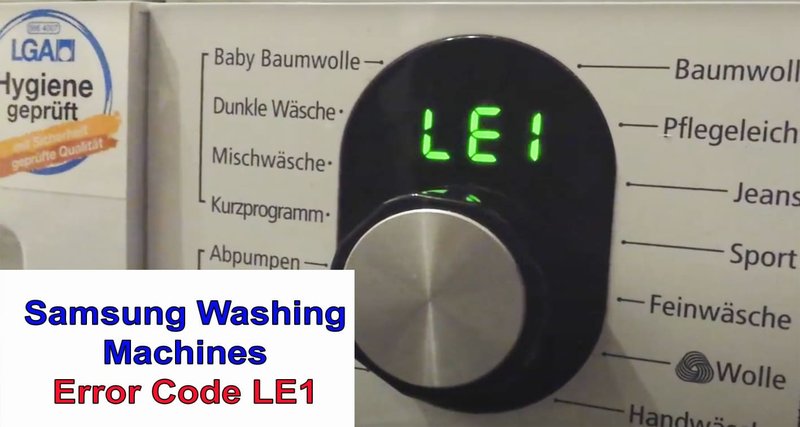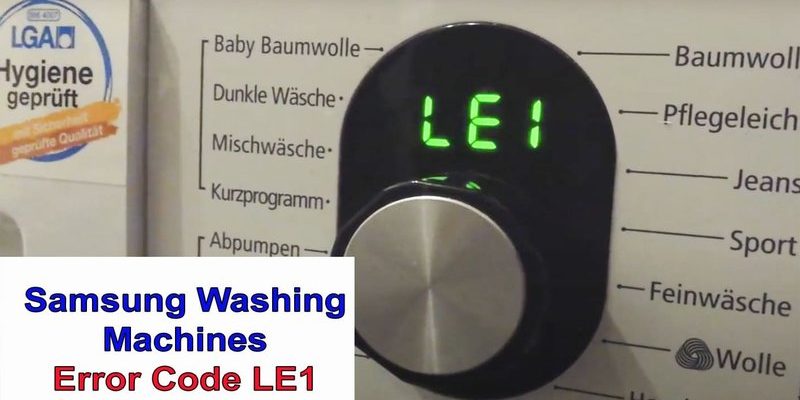
The “LE” error code is Samsung’s way of telling you something is amiss. In everyday terms, think of it as your washing machine waving a little red flag. It’s often related to issues with water levels—the machine might think it’s got too little or too much water, or sometimes it’s about a drainage problem. Let’s unravel this mystery and dive into the common causes and how you can address them.
Understanding the “LE” Error Code
First things first, when your washing machine displays “LE,” it’s crucial to know that it isn’t an outright failure or breakdown. This code indicates that the machine’s internal sensors have detected an issue it can’t fix on its own. It’s basically a smart warning system alerting you about a condition that needs attention.
Imagine your washing machine like a chef in a kitchen. Just as a chef needs the right amount of ingredients to whip up a perfect dish, your washing machine needs the right balance of water for its cycles. When the balance is off, it’s like trying to bake a cake without enough flour—it just won’t turn out right. The “LE” code is largely about ensuring this balance to maintain optimal performance.
This error can often be traced back to water-related issues. It might be a problem with the water supply, blockages in the drainage system, or a malfunctioning sensor that’s sending incorrect readings. Understanding what could be wrong is half the battle won, as it makes troubleshooting much easier and more efficient.
Common Water Supply Issues
One of the primary culprits behind the “LE” error code is water supply issues. Just like a plant can’t thrive without enough water, your washing machine can’t operate properly if it isn’t getting the right water supply. The first step is to check if the water taps are fully open. Sometimes, in the hustle and bustle of daily life, taps can be nudged or accidentally turned off.
Another factor is the water pressure. If the pressure is too low, it could prevent your washing machine from filling up correctly. You can compare it to trying to fill a bucket with a trickling hose—you’re going to be waiting for a while. Low water pressure might be caused by a kinked hose or issues within your home’s plumbing system. In such cases, inspecting the hoses for any twists or bends and ensuring a steady flow can often resolve the problem.
Sometimes, valves that control the water inflow can also be at fault. If these valves are clogged or faulty, they might restrict water entry, mimicking low water pressure. Regular inspections and cleaning can go a long way in preventing such issues, keeping your washing machine happy and error-free.
Troubles with Drainage Systems
Next up, let’s talk about drainage. An efficient drainage system is as crucial to your washing machine as rain is to a thriving garden. If your machine isn’t draining properly, it can lead to an “LE” error displaying on the screen. This issue often arises when there’s a clog or obstruction somewhere in the drainage path.
You might find that the drain hose is blocked, much like a leaf clogging a gutter during a storm. To troubleshoot, carefully remove and inspect the hose for any debris or kinks that might be impeding water flow. Ensuring the hose is free and clear can often resolve drainage-related error codes.
Another thing to check is the drainage filter, which can become clogged with lint, small clothing items, or other residues. Regularly cleaning this filter is akin to changing the oil filter in your car—it’s essential maintenance that keeps everything running smoothly. If these steps don’t solve the issue, you might need to delve a bit deeper into the drainage pump and its components, which might require professional help.
Sensor and Internal Component Issues
Imagine trying to dance to music that’s too quiet to hear properly—frustrating and difficult, right? In the same way, your washing machine depends on sensors to provide the right “tune” for its operations. If these sensors malfunction, they might cause an incorrect “LE” error to appear.
The water level sensor is a common suspect in these cases. It’s like the metronome for your washing machine, making sure everything’s in sync. If it’s not working, your machine might misinterpret the water level, triggering an error. Inspecting and potentially replacing the sensor can often clear up the issue.
Internal wiring or electronic glitches can also lead to sensor problems. While it sounds complicated, it’s a bit like checking if your headphones are plugged in when you can’t hear the music. A loose connection or a worn-out wire might be causing the trouble. Sometimes, simply resetting your washing machine by turning it off and on again can resolve minor electronic hitches.
Next Steps and Prevention Tips
So, you’ve tackled the “LE” error code. Now what? Once everything’s working smoothly again, you can take some simple steps to help prevent these issues from cropping up in the future. Regular maintenance is key. Just like you wouldn’t skip a car service, taking time to check the hoses, filters, and valves can keep everything running like a dream.
Consider running an empty cycle with a bit of vinegar or a commercial cleaning solution every few months. This keeps mold and residue at bay, ensuring sensors and components remain clean and functional. It’s a simple practice that pays off in the long run.
Finally, if you’re frequently encountering issues, it might be worth consulting a professional. They can provide a thorough assessment and fix underlying problems you might not be able to detect. Remember, it’s always better to deal with small issues before they balloon into larger ones. Hopefully, these tips help keep your laundry days smooth and error-free!
